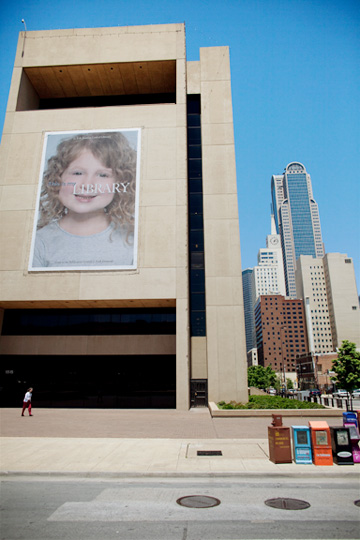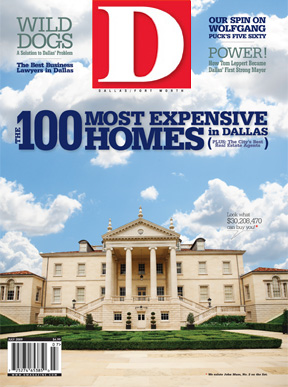With all the hoopla attendant on the Dallas Center for Performing Arts, and on the architecture of the Arts District, the focus on the north and western sides of downtown Dallas, I decided to take a stroll and take a look at the opposite side, along Young Street, and across from City Hall. It is there that you’ll find the J. Erik Jonsson Central Library, the poor, undernourished stepsister to those offspring of Pritzker winners, the glamour-pusses in the world of high culture.
I had been prepared for the worst. A front page article in the New York Times in April reported on how city libraries across the country have turned into holding pens for homeless people, who sit, sprawl, and snooze there, and who use the bathrooms as changing facilities. In two worst-case scenarios, one in Illinois and the other in Virginia, two guys got into a knife fight on one library’s front steps, and a gunman shot someone outside of another; the victim then staggered, bleeding, into the library. This kind of stuff didn’t happen when I was a bookish child. Libraries made you feel safe. Under the stern guidance of the shushing, schoolmarmish librarian, you did your work, lost yourself in books, borrowed them one week and returned them the next. For many of us, getting a library card was the most important of life’s many rites of passage.
Three visits to the Dallas Public Library surprised me, pleasantly. Young Street—the whole strip between the Library and City Hall—is not a thing of beauty. At best it’s a serviceable, charmless thoroughfare. On hot sunny summer days, it has something of the effect of an eerie De Chirico painting: even with people present, you feel that the vast expanse of concrete dehumanizes pedestrians.
Once inside, the scene changes. There are signs of life. Tranquility prevails. You find yourself in an acceptable, if not totally ideal, quiet well-lighted place, just the thing for reading and research. No men’s room I walked into required me to hold my nose—as I had been forewarned would be the case by several skeptics who obviously had not visited recently. Some people dozed; some sat at tables reading. Most were seated in front of computer screens. I walked up and down to look over their shoulders. What were they reading? A few had something scholarly or literary on the screen. More were pursuing employment and resumé-building opportunities, part of a national trend in library use as a result of the recession. And most seemed to be looking at YouTube, MySpace, Facebook, or doing some Internet comparison-shopping. One hapless guy was looking at a site headlined “Meet Single Lonely Women.” Why not? Bookworms tend to be loners to begin with.
And guess what? Most of my students at the SMU library are glued to the same sites. Scholarly research isn’t the only, or even the primary, thing on their minds.
The J. Erik Jonsson Central Library opened in 1982, the Dallas Public Library’s third home. This “house of information and recreation” (in the words of Laurie Evans, its current director) has changed with the times, of course, like all libraries, but has remained true to the vision and motives of the original founders who, 110 years ago, sought out Andrew Carnegie for a benefaction. May Dixon Exall, annoyed if not incensed that the philanthropist had already endowed a Carnegie Library in Fort Worth, wrote a dunning letter, and Dallas got into the game. It’s been playing that game ever since, through thick and thin, battling philistines, the KKK, and less than perfect physical conditions (read: in its prior homes, overcrowding, bad climate control, and leaking roofs).
During the downturn of the late 1980s, the library suffered draconian budgetary cutbacks—as it does once again. With the city facing a $100 million budget shortfall, it has proposed cutting back the library’s hours. A decision will be made by October. Private patronage, through the Friends of the Dallas Public Library for the past 59 years, has always supplemented the budget from City Hall. Each floor, in succession, has had a makeover, all with private support. Courtesy of the Dallas Shakespeare Club, the Central Library now owns a copy of Shakespeare’s First Folio. Of greater usefulness is one of the original broadside copies of the Declaration of Independence. Both sit in glass cases.
Why the First Folio? Depending on its condition, this volume is worth between $1 million and several million. A former SMU colleague of mine recommended to the Shakespeare Club that they could purchase all of the books ever written about Shakespeare for that kind of money. People would actually use the books. You can’t use the Folio. If you wanted actually to examine one, you could go to numerous research libraries (Washington’s Folger Shakespeare Library has 79 copies) or use a beautiful facsimile. The First Folio sits on display, like a trophy wife. Somehow, its status befits its residency in Dallas.
Michael V. Hazel has told the whole story in his centennial history of the library. It’s not a sexy story, although it makes for engaging reading especially to people with a debt to, and an appreciation of, libraries themselves. Bookish types tend to selfishness but also, paradoxically, to common sense. As Laurie Evans reminded me, “People who support libraries tend to be pragmatic in their understanding that without great libraries there are no great cities.” And pragmatic, also, in knowing how to get things done. Thus, the names of DPL patrons are long familiar in Dallas charitable circles: especially those of the Jewish merchant princes, Marcus, Sanger, Kahn, Harris. If you build it—department store or library—they will come. (Mr. Stanley knew that.) And they have.
In the 21st century, libraries filled with books may seem quaint, even old-fashioned. Thank goodness. They provide havens for escape and engagement. They still do what they have always done. According to Evans, 6,000 patrons a day come through the doors downtown.
Libraries serve, indeed they make, citizens. In the long age of mass immigration that stretched from the middle of the 19th through the middle of the 20th centuries, they were the classrooms of the poor, the aspiring, and the soon-to-be Americans. The great neoclassical, pillared library buildings in Boston, New York, and Philadelphia all attest to the quasi-religious functions these intellectual temples have served.
In Dallas, as elsewhere, the branch libraries are the even poorer cousins of the poor step-sister. But they survive; they even flourish. I visited my local branch, on Cedar Springs in Oak Lawn, one Saturday morning. At the small desks and in the lounge chairs, I saw guys reading the Wall Street Journal and the New Yorker as well as the expected websites. In a small room a knitting group of three women, accompanied by a book-reading male companion of one of them, held its weekly session. The library now functions as a community meeting-place. In one side room, an ESL class was going through its paces. In the open reading space, it was hard to tell who was reading for pleasure, who was doing scholarly work, and who had simply parked himself to get indoors, out of the elements. A helpful librarian told me that the staff tries to treat the non-patrons with courtesy and respect. If someone is sleeping soundly, he is gently awakened. (I was somewhat taken aback: I have spent hundreds of pleasant hours in libraries snoozing. I count this time as a vital part of my intellectual labors.)
The same busy Saturday, I drove to NorthPark. It has plenty of gorgeous designer boutiques, most empty of customers, but no bookstore. (You have to go to Barnes & Noble, across Northwest Highway.) I had come to have a look at Bookmarks, open since June 2008. It’s another private-public collaboration, the first children’s library in a shopping center. And why not? That’s where the people are. Little kids were reading, drawing, playing, noodling on terminals. Ray Nasher must have been smiling down.
On the last of my trips to the Central Library, I stopped to ask whether I might log onto one of the computers to drop an e-mail to someone. I have no iPhone, no BlackBerry, so I am still trapped in 20th-century technology. The friendly attendant behind the desk asked to see my identification, and I handed over my driver’s license.
“Don’t you have a library card?” he asked.
“No, I don’t,” I replied.
“Why not?”
“I teach at SMU, and I use the libraries there.”
“Sir, you need to have a Dallas Public Library card, and I’m going to make one for you right now.”
All of a sudden the decades melted away. I was a first-grader again, getting a hand-written paper card, and being shown to the stacks where the books stood, beckoning. I think I must have teared up. “Why, thank you so much,” I said, and, forgetting my motive of sending an e-mail, I headed to the stacks and took out a book that I didn’t even need. I returned it the following week.
Willard Spiegelman’s most recent book is Seven Pleasures: Essays on Ordinary Happiness (Farrar, Straus and Giroux, 2009). Write to [email protected].






